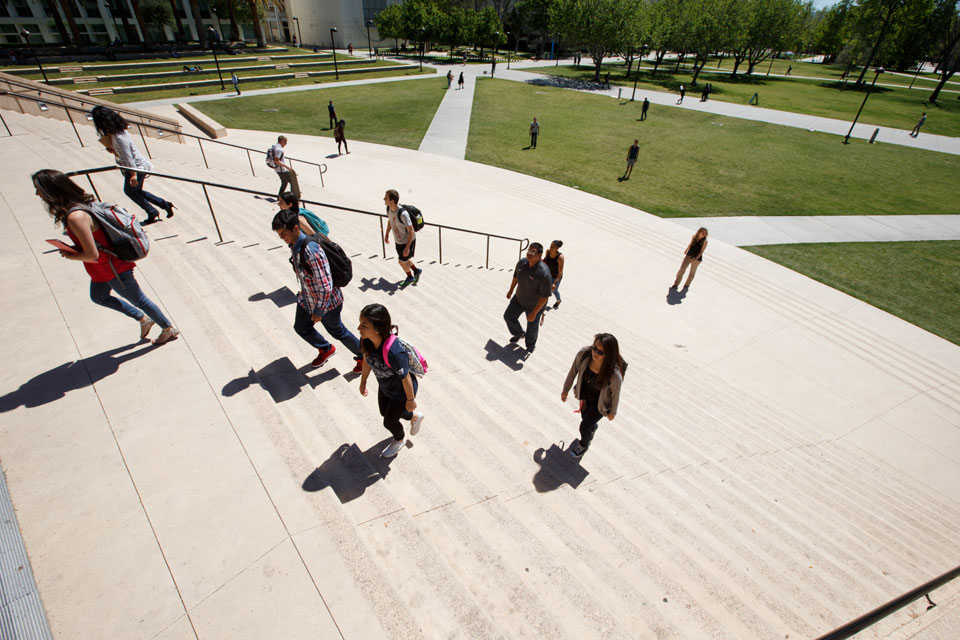CSUN Part of National Effort to Create Sustainable Change in Student Success

CSUN has joined a national effort,aimed at ensuring success for all students, particularly those who historically have been underserved by higher education.
California State University, Northridge has joined a national effort, called Re-Imagining the First Year of College, aimed at ensuring success for all students, particularly those who historically have been underserved by higher education — students who are low income, first generation or persons of color.
A coalition of representatives from 44 colleges and universities, all members of the American Association of State Colleges and Universities (AASCU), will be working together for three years to develop comprehensive, institutional plans to redesign the first-year college experience and create sustainable change for student success. The project is being supported by the Bill & Melinda Gates Foundation and USA Funds.
“This is a wonderful opportunity to share best practices with the other 43 institutions,” said English professor Cheryl Spector, director of CSUN’s Academic First Year Experiences. “It will be tremendously helpful to have support from nationally recognized experts as well.”
AASCU President Muriel Howard said the association and its members historically have been committed to student success, “with particular concern for those students who have shown great promise but who have encountered stumbling blocks along the way.”
“The Re-Imagining the First Year of College initiative is further testament to this commitment,” Howard continued. “It is a groundbreaking collaboration that we believe will substantively and sustainably alter the first-year experience for students at the 44 AASCU-member institutions that are participating.”
The first year of college has been identified as a critical time in a college student’s academic career — the point when they decide whether to continue their studies or drop out. The project’s organizers recognize that no single intervention is a solution to the retention problem, and that some solutions fail to reflect the differing needs of a changing student body.
Organizers of the Re-Imagining the First Year effort are hoping to inspire redesigned approaches that work effectively for all members of an increasingly diverse and multicultural undergraduate student body.
The institutions participating in the effort will form a learning community that reviews and shares evidence-based practices, programs and implementation strategies. The initiative is designed to include a comprehensive “top-down, bottom-up” approach that engages the whole campus in focusing on four key areas to help first-year students succeed: institutional intentionality, curriculum redesign, changes in faculty and staff roles, and changes in student roles.
Other California State University campuses taking part in the effort include Cal Poly San Luis Obispo, CSU Channel Islands, CSU Dominguez Hills, Humboldt State, CSU Long Beach and CSU Monterey Bay.
Four members of CSUN’s community — Helen Heinrich, director of data and analytics for the university’s division of Information Technology; Patrick Bailey, director of student involvement and development; first-year experience librarian Susanna Eng-Ziskin and Spector — attended a conference last week on the initiative. Spector said they returned “energized with new possibilities and pleased to recognize how much important work is already underway at our campus.”
Spector said members of the team were happy to discover that CSUN already was implementing many of the suggestions made to improve the first-year experience, “though we really are hoping to rethink even the things that are working.”
She pointed to one example: A speaker suggested attendees reconsider the letter campuses send first-year students when they are placed on academic probation. Instead of being stern and threatening, accusing the recipient of “failing” to meet the institution’s high academic standards, the letter could explain the probationary process and give struggling students the name and contact information of someone on staff who could help them take the steps to rectify the situation.
“If you’re talking about struggling first-year students, you don’t want them to give up,” Spector said. “You want to turn them around. I can imagine that if you are a freshman and you receive a letter that implies you have failed, it could be the last straw and you might decide it was just time to give up. We don’t want that to happen.”
One of the key areas in the initiative, “institutional intentionality,” means “establishing a culture of obligation, where everybody on campus recognizes that we are here to serve the students and promote student learning,” Spector explained.
“There are many ideas that I think could be put into action to serve our students,” she said. “The challenge is for us to figure out which ideas fit together best and match our campus’s possibilities best.”

 experience
experience